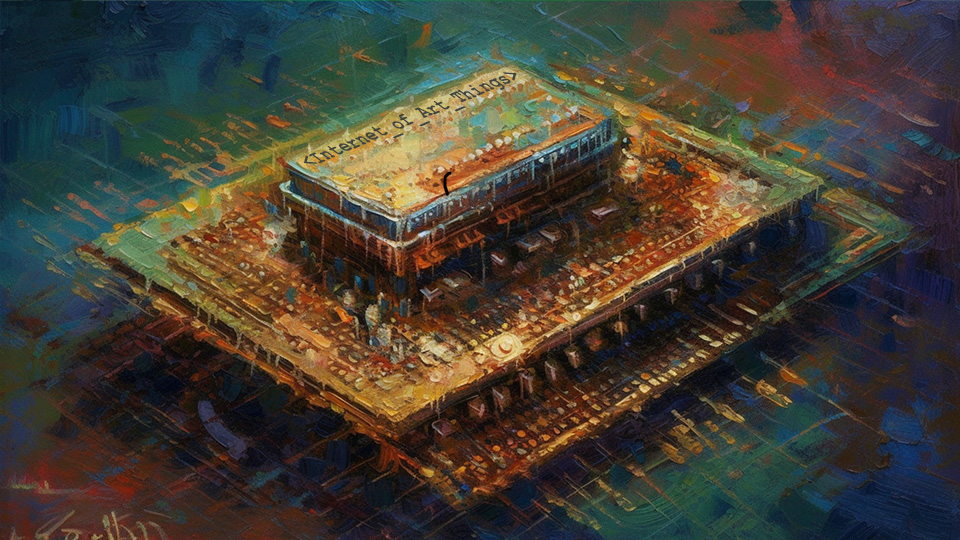

Internet of Art Things
-
MediumMicroprocessor & Paint
-
Year2019
-
ExhibitedSawyer Silos, Houston
-
Website
About
SINTRON's "Internet of Art Things" is a subtle yet evocative triptych that melds traditional canvas work with the cutting-edge realm of IoT (Internet of Things) technology. It presents two distinct 24x36" panels on the left and right, each swathed in grey spray paint with ghostly remnants of past stencil paintings peeking through the monotone. The choice of words, "DIRT" on the left and "CHEAP" on the right, emerges from these canvases in a stark contrast using sticker lettering. Sandwiched between these two is a slightly smaller canvas, dominated by a thick black border that frames a luminous center - a blend of chrome and glow-in-the-dark spray paints. This center canvas, when plunged into darkness, becomes a beacon, highlighting a small ESP8266 microcontroller. This device, which allows viewers to connect via Wi-Fi, not only showcases the triptych itself but audaciously offers the side panels for purchase, thrusting the art piece into the world of digital commerce without the intervention of any human mediator.

Living on the Edge
In the "Internet of Art Things", SINTRON crafts a narrative that isn't just a visual experience but a meta-commentary on the rapidly evolving interplay between art, commerce, and technology. The left and right panels, labeled "DIRT" and "CHEAP", might be viewed as a critique on the commodification of art or perhaps as a reflection on how technology often diminishes the perceived value of traditional artistic mediums. The ghostly remnants of previous stencil artworks beneath the grey layers evoke feelings of nostalgia, past, and transformation, acting as vestiges of an era overtaken by the relentless march of technology.
The centerpiece is where SINTRON's ingenuity truly shines. By incorporating an IoT microcontroller, he doesn't just weave technology into his artwork – he challenges the conventions of art sales and exhibition. This piece not only critiques but embodies the evolving dynamics in the art world where technology, particularly edge computing, is decentralizing and automating processes once thought irrevocably human-centric. It prompts the viewer to consider where technology is taking our world and how its ubiquity might redefine our value systems.

A Light in the Darkness
In darkness, the center canvas's glow-in-the-dark feature becomes a metaphor for the illumination technology provides in an otherwise opaque world, with the microcontroller acting as a beacon of this transformation. However, while the piece brilliantly utilizes technology, it could be argued that the use of overt labels like "DIRT" and "CHEAP" might oversimplify the complexity of the relationship between art, technology, and commerce.
Moreover, the luminous center during darkness also serves as a contemplative point. In a world frequently overwhelmed by the noise of countless technologies, SINTRON's work underscores the beacon-like quality of art. Even when everything else might seem uncertain and obscure, art – whether traditional or digital – remains a guiding light, a constant, and a source of introspection.

Dying on the Edge
SINTRON's "Internet of Art Things" is an enterprising exploration of the shifting sands of art in a digitized world. It is not just art, but art aware of its place in a world on the cusp of technological singularity.
In essence, "Internet of Art Things" can be seen as a reflection on the various impending "deaths" brought about by the relentless march of technology and the changing dynamics of the art world in response. However, it's essential to recognize that while certain concepts or methods may be in decline, they give way to new forms of expression, engagement, and understanding. In this transformative cycle, death becomes not an end but a precursor to rebirth.

